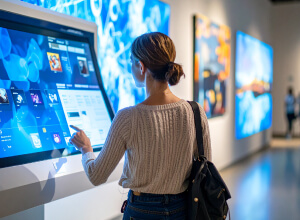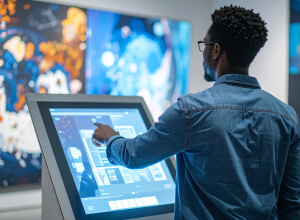The Role of Interactive Digital Signage in Smart Cities
.png)
Discover how interactive digital signage enhances smart cities by improving communication, citizen engagement, sustainability, and smart mobility with AI, IoT, and real-time data integration.
Cities around the globe are evolving into smart cities, leveraging cutting-edge technology to improve urban living. This dynamic transformation relies heavily on integrating IoT, AI, and interactive digital signage to create efficient, sustainable, and engaging environments.
Interactive digital signage is pivotal in smart city infrastructure, enhancing communication, citizen engagement, and overall city management. This blog post explores the multifaceted role of interactive digital signage in smart cities, providing valuable insights for companies looking to capitalize on this technology.
What Is Interactive Digital Signage?
Interactive digital signage refers to electronic displays that allow users to interact with content through touchscreen technology or other input methods. These systems are designed to provide real-time information, services, and engagement opportunities in urban settings.
Types of Interactive Displays
Interactive displays come in various forms, including kiosks, digital billboards, and interactive wayfinding systems. Each type serves a unique purpose, from providing information to guiding visitors through complex urban landscapes.
The Role of Interactive Digital Signage in Smart City Infrastructure
Communication Hub
Interactive digital signage can act as a real-time communication tool for city services, emergency alerts, and public information. It ensures that citizens are informed and can access vital information quickly and efficiently.
Integration with Smart City Systems
Digital signage can be seamlessly integrated with other smart city systems, such as traffic management and public transportation. This integration enhances the overall functionality and responsiveness of urban infrastructure.
Wayfinding and Navigation
Interactive signage is crucial for wayfinding solutions, especially in large urban areas, transportation hubs, and tourist hotspots. It helps visitors and residents find their way, reducing confusion and improving the overall city experience.
Usage Scenario One: Enhancing Citizen Engagement and Public Services
Interactive Public Services
Digital kiosks and interactive screens facilitate public access to information, city services, and e-government platforms. They streamline processes and make it easier for citizens to interact with government services.
Citizen Feedback
Interactive signage permits real-time citizen engagement, collecting feedback, conducting surveys, and providing live updates. This interaction helps city officials understand public sentiment and make data-driven decisions.
Accessibility
Digital signage can be customized for better accessibility to accommodate people with disabilities through features like text-to-speech and multilingual support. This inclusivity ensures that all citizens can benefit from smart city technologies.
Usage Scenario Two: Smart Advertising and Economic Growth
Personalized Content Delivery
Integrated with sensors and enhanced with conditional logic, digital signage can deliver targeted advertising based on real-time data, such as demographics, location, and weather. This personalized approach increases the relevance and effectiveness of advertisements.
Revenue Generation
Cities can monetize public spaces by offering ad spots on interactive digital signage to local businesses and national advertisers. This additional revenue stream supports city budgets and fosters economic growth.
Tourism Boost
Interactive signage for tourists, with real-time maps, restaurant recommendations, and event information, encourages spending and engagement in critical areas. It enhances the visitor experience and drives economic benefits.
Usage Scenario Three: Improving Smart Mobility and Traffic Flow
Real-Time Traffic Updates
Interactive digital signage displays live traffic conditions, public transport schedules, and parking availability. This information reduces congestion and improves travel times, making urban mobility more efficient.
Integrated Mobility Solutions
Digital signage aids in smart mobility initiatives, such as electric vehicle (EV) charging stations, bike-sharing programs, and car-sharing services. These solutions promote sustainable transportation options and reduce the city's carbon footprint.
Value of Interactive Signage for Sustainability and Green Urban Planning
Energy Efficiency
Interactive digital signage systems use LED screens, solar power, and low-energy consumption components. These features enhance energy efficiency and contribute to sustainable urban development.
Reduced Paper Waste
Shifting from traditional advertising and information dissemination methods to digital displays significantly reduces paper waste. This environmentally friendly approach aligns with green urban planning initiatives.
Support for Sustainable Initiatives
Digital signage can be used to promote eco-friendly campaigns, smart waste management, and energy-saving tips for residents. It raises awareness and encourages sustainable behaviors among citizens.
The Future of Interactive Digital Signage in Smart Cities
AI and Machine Learning
The potential for AI-driven signage to predict trends and offer hyper-personalized content is immense. These advancements will further enhance the relevance and effectiveness of digital signage in smart cities.
5G and Enhanced Connectivity
The advent of 5G networks will revolutionize the speed and reliability of digital signage systems. Enhanced connectivity will enable real-time updates and interactions, making digital signage more responsive and dynamic.
Data-Driven Smart City Planning
Interactive digital signage collects real-time data on pedestrian and vehicular movement. This data informs urban planning and optimizes space utilization, leading to more intelligent and efficient cities.
Conclusion
Interactive digital signage is a critical component of smart city development. It enhances public engagement, improves city management, and drives economic growth. As technology continues to evolve, the role of interactive digital signage in urban landscapes will only become more significant.
By investing in interactive digital signage, companies can position themselves at the forefront of smart city innovation. This technology not only improves urban living but also offers numerous business opportunities. For those looking to further explore the benefits of interactive digital signage, consider connecting with industry experts and exploring the latest advancements in this field.





